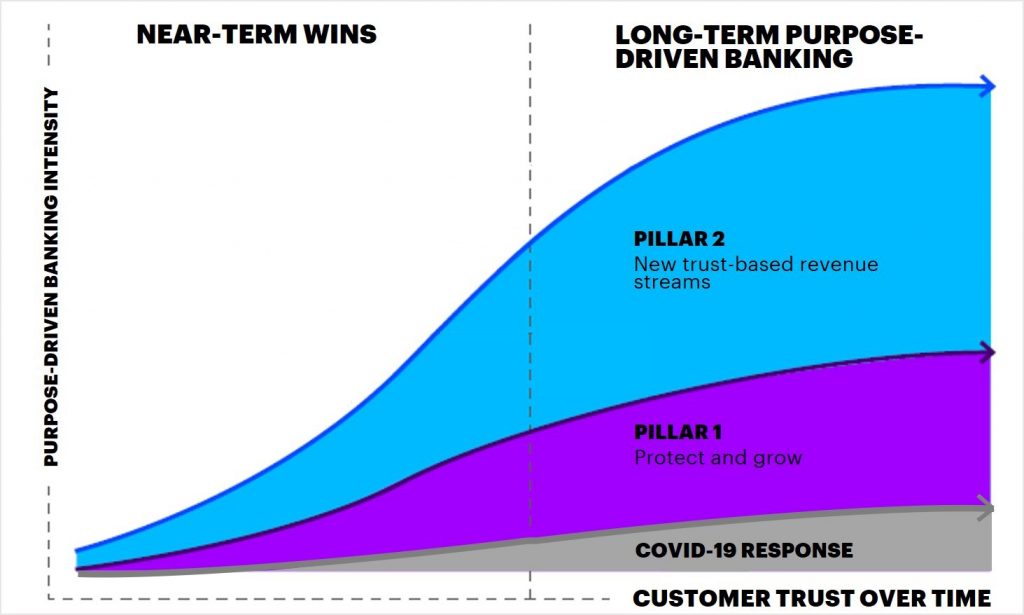Other parts of this series:
In my last blog, I pointed out that low advisory trust is the underlying cause for five percent of banks’ retail revenues being at risk. To address this threat and grow their business, banks need to build customer trust and create win-win relationships that endure over time.
For starters, banks can sustain the understanding, empathy, speed and agility that’s been a big part of their response to the health crisis so far. Quick action to provide payment holidays for consumers, liquidity for SMEs and other relief efforts are helping customers deal with challenging economics—and should be built into their operations going forward.
Next, I believe this is the ideal time for banks to rediscover their original purpose: to help customers better manage their finances, even if doing so generates no immediate benefit for themselves. This would entail self-cannibalising the “bad revenue” which is at risk as regulators and digital challengers put pressure on traditional banks that benefit from it. Helping customers avoid these fees will establish banks’ good intentions. It will show that the customer’s interests really do come first and that the bank can be trusted to give good, impartial advice.
This improvement in trust will lay a solid foundation from which banks can launch a host of innovative new advisory services. To realise this ambition, we believe they need to take key actions around two strategic pillars, illustrated in the graphic below.
Pillar 1 focuses on immediate changes to give customers the right tailored advice in ways that also protect and grow the bank’s market share. It includes increasing efficiencies, improving customer understanding, adopting personalisation and increasing customer acquisition and retention.
Pillar 2 emphasises a steady shift to expand the scope of financial advice, with the bank going further to address customers’ unmet needs and opening up new trust-based revenue streams. With sufficient trust, these advisory propositions can go beyond financial products to broader spend-management advice.
This is an opportunity for banks to reaffirm their purpose of being solidly on the side of the customer, and doing so in very personalised, authentic, empathetic and digital ways.
Implementing these strategies simultaneously will help banks develop long-term, win-win advisory relationships where customers naturally turn to them first for financial guidance. Our analysis indicates it can deliver an average nine percent revenue uplift to banks over time. This comprises a bigger share of customers’ wallets, the acquisition of new clients, increased retention, additional new revenue streams and what we call a “trust-kicker effect”: the potential revenue uplift gained by the most trusted players in their respective markets.

Purpose-Driven Banking 2021 report: Driving powerful transformation for banks.
LEARN MOREAnd at a time when many people are concerned about income stability and meeting their financial responsibilities, they need help from the bankers they know. This is an opportunity for banks to reaffirm their purpose of being solidly on the side of the customer, and doing so in very personalised, authentic, empathetic and digital ways. The win-win partnerships that emerge from this can go a long way in helping a bank stand out from the crowd.
In the third and final post of this series, my colleague Michael Abbott will dive into the detail of what Pillar 1 and 2 initiatives look like—and how they translate into far more relevant, personalised and differentiating trust-based conversations and relationships.
For more on this topic, view our other Purpose-Driven Banking content:













Interesting to see if the investment in pillar 1 may see banks looking to collaborate more as a collective or continue to forge their own way and whether the challengers will again lead the way. Surely that would be in the best interests of regaining customer and consumer trust – or am I being too idealistic?
Easiest path for the incumbent banks is to have change regulated for everyone rather than having to cannibalize. What has made the pivot to customer focus easy during COVID has been the blanket requirements for payment holidays and low-cost overdrafts. When those requirements disappear I think you will see the incumbents revert to different competitive strategies on Pillar 1.